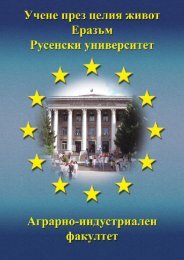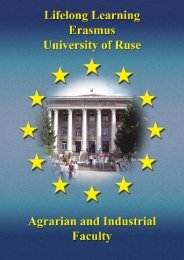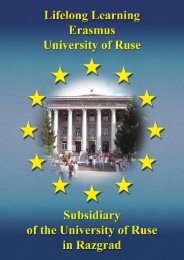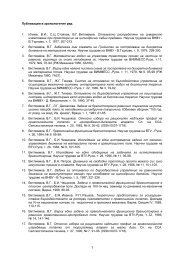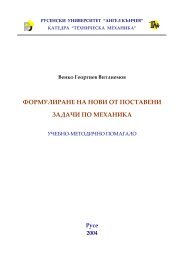Erasmus ECTS Information Package
Erasmus ECTS Information Package
Erasmus ECTS Information Package
Create successful ePaper yourself
Turn your PDF publications into a flip-book with our unique Google optimized e-Paper software.
<strong>Erasmus</strong> <strong>ECTS</strong> <strong>Information</strong> <strong>Package</strong><br />
Faculty of EEEA<br />
3067 Discrete Structures and Modelling<br />
<strong>ECTS</strong> credits: 6<br />
Weekly classes: 2lec+0sem+0labs+2ps+2cw<br />
Assessment: exam<br />
Type of exam: test<br />
Departments involved:<br />
Department of Computing<br />
Faculty of Electrical Engineering, Electronics and Automation<br />
Lecturer:<br />
Assoc. Prof. Irina Ilieva Zheliazkova, MEng, PhD, Dept. of Computing, tel.: 888 744,<br />
E-mail: Irina@ecs.uni-ruse.bg<br />
Abstract:<br />
The course gives theoretical knowledge and practical skills for modelling with systems of equations, graphs, sets,<br />
graphs, Petri nets, Markov chains, image recognition for analysis, synthesis, and optimization of complex systems.<br />
Course prerequisites include Advanced mathematics 3, Programming and Computer Applications, Synthesis and<br />
analysis of algorithms and is linked to Software engineering, Programming languages, and the work projects.<br />
Course content:<br />
Physical modelling with systems of equations. Data modelling with sets. Structural modelling with graphs.<br />
Behaviour modelling with Petri nets. Probability modelling with Markov chains. Modelling image recognition.<br />
Teaching and assessment:<br />
The lecture material for the separated mathematical apparatus includes: definitions, types, properties, setting,<br />
algorithms and methodology for modelling. Practical exercises are reduced to the acquisition of algorithms for<br />
solving different types of problems with different tools. The results from each exercise for each student are<br />
assessed by the assistant. Course work includes implementation of a program for modelling using one of the types<br />
of sets, or one of the image recognition methods. The final assessment of the course is formed as an average of<br />
the practical exercises, course work, and a test on the lecture material marks.<br />
3068 Object-oriented programming<br />
<strong>ECTS</strong> credits: 5<br />
Weekly classes: 2lec+0sem+0labs+2ps+1ca<br />
Assessment: exam<br />
Type of exam: written and oral<br />
Department involved:<br />
Department of Computing<br />
Faculty of Electrical Engineering, Electronics and Automation<br />
Lecturers:<br />
Assoc. Prof. Milko Todorov Marinov, MEng, PhD, Dept. of Computing, tel.: 888 356,<br />
E-mail: mmarinov@ecs.uni-ruse.bg<br />
Assoc. Prof. Svetlana Petrova Stefanova, MEng, PhD, Dept. of Computing, tel.: 888 356,<br />
E-mail: sstefanova@ecs.uni-ruse.bg<br />
Principal Assistant Julia Stoyanova Zlateva, MEng, Dept. of Computing, tel.: 888 681,<br />
E-mail: JZlateva@ecs.uni-ruse.bg<br />
Abstract:<br />
The course objective is for the students to familiarise themselves and to practically assimilate the methodology of<br />
object-oriented programming (OOP) as a basis of many modern languages and systems for developing computer<br />
applications. The course focuses on the practical application of the approach by using universal library functions<br />
as well as developing own functions.<br />
Course content:<br />
Introduction to OOP. Classes and objects – definitions. Constructors and destructors. Data members. Member<br />
functions. Overloaded functions. Inheritance. Multiple inheritance. Virtual classes. Virtual functions. Polymorphism.<br />
Template class library. Working with streams.<br />
Teaching and assessment:<br />
The lecture topics give the main theoretic aspects of the problems. The practice sessions and course work classes<br />
are conducted in a computer lab. The students have to independently solve, encode and test with the aid of a<br />
specific programming environment elements of given problems. Each student is assigned an individual task, which<br />
they have to complete by the end of the semester. The final mark is a weighted average of four marks: activity<br />
during practice sessions, implementation of the individual task, written report and final exam.<br />
156



